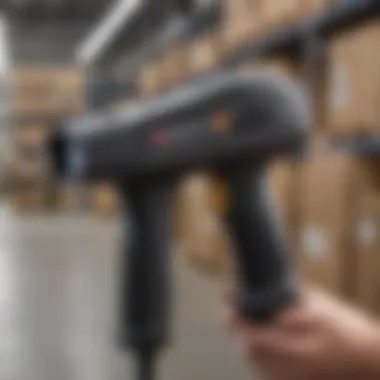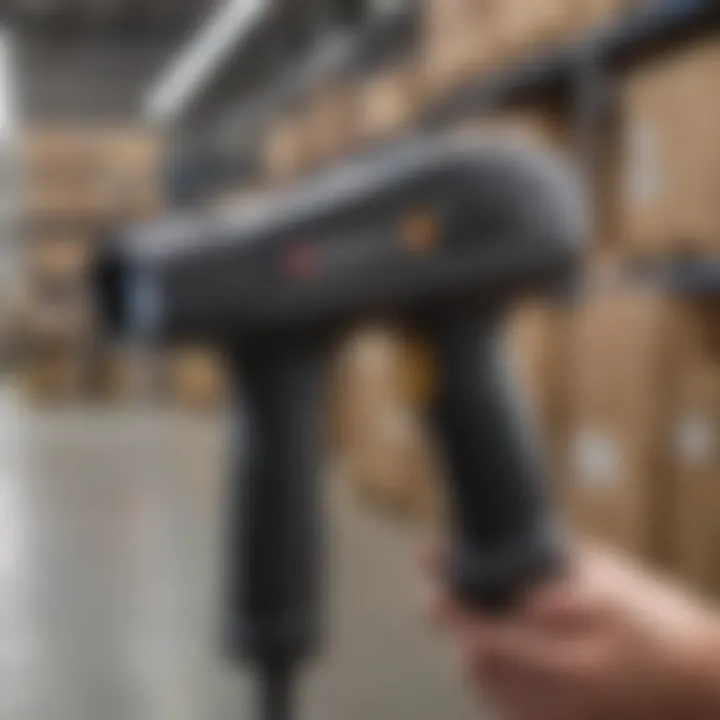The Role of Barcodes in Warehouse Management


Intro
In today’s fast-paced business landscape, warehouses serve as the backbone of supply chain management, ensuring that products are stored, sorted, and dispatched efficiently. The introduction of barcode technology has revolutionized this domain. It transformed how inventory is tracked, offering significant gains in productivity and accuracy. Let’s delve into how barcodes play an essential role in streamlining warehouse operations, enhancing not just the speed of processes, but also accuracy in inventory management.
Entrepreneurial Insights
As businesses venture into the realm of warehouse management, understanding the significance of barcodes becomes paramount for entrepreneurial success. At its core, barcode technology eliminates human error and inefficiencies that are often associated with manual inventory tracking. This results in lower operational costs and improved customer satisfaction.
Entrepreneurial Success Stories
Many small businesses have seen incredible successes through adopting barcode systems. For example, a local bakery that set up a barcode system for tracking ingredient usage noticed a sharp decrease in wastage. This allowed them to allocate funds differently and even expand their business. This story showcases how the adoption of seemingly simple technology can impact bottom lines significantly.
Challenges Faced by Entrepreneurs
Despite the evident advantages, integrating barcode systems can also pose challenges. Issues such as initial costs, training staff to manage the new system, and ensuring all products are properly labeled can hinder the process. Entrepreneurs must be willing to navigate these obstacles, often requiring a strategic approach and clear long-term vision to reap the rewards.
Tips for Aspiring Entrepreneurs
For those looking to integrate barcodes into their warehouse management, consider the following tips:
- Start small: Pilot the system on a limited scale before full deployment.
- Training is key: Ensure staff is well-trained to avoid resistance against change.
- Regular updates: Keep software and hardware updated for optimal performance.
Technology Behind Barcodes
The technology that drives barcodes is fascinating. A barcode is a pattern of parallel lines and spaces that can be scanned, read, and converted into information. It works through the principles of light reflection and detection.
Barcodes can be classified into several types: 1D (like UPC codes) and the more advanced 2D (like QR codes). Understanding the technicalities of these codes can give business owners insight into which type best fits their needs.
Applications of Barcodes in Warehousing
Barcodes find applications across various processes:
- Inventory Management: Barcodes help in tracking stock levels in real-time, ensuring better visibility.
- Order Fulfillment: Scanning items while fulfilling orders reduces errors significantly.
- Receiving and Shipping: Scanning barcodes on incoming and outgoing goods streamlines the entire process.
Advantages Over Traditional Methods
Switching from traditional inventory methods to barcodes offers a myriad of benefits:
- Increased Efficiency: Processes are expedited, minimizing delays.
- Reduced Errors: Automated systems lower the likelihood of mistakes common in manual inputs.
- Better Data Accuracy: Real-time scanning means data is more accurate and up-to-date.
Challenges in Barcode Integration
While barcode systems offer substantial benefits, their integration isn’t without hurdles. Challenges like ensuring all products are correctly labeled, maintaining equipment, and training personnel can pose significant roadblocks. Businesses that anticipate these issues and approach them proactively are likelier to succeed with their barcode implementation.
Best Practices for Effective Barcode Implementation
To ensure the smooth integration of barcodes within warehouse management systems, consider these best practices:
- Conduct thorough inventory audits before implementation to understand current stock levels and labeling needs.
- Create clear labeling protocols for all products to avoid confusion.
- Invest in reliable scanning devices and ensure they are compatible with your inventory management software.
"Properly implemented barcode systems can transform warehouse management from a tedious task to a seamless operation."
Closure
Emphasizing the role of barcodes in modern warehouse management, it is evident that they are more than just a simple technology. They represent a shift towards efficiency, accuracy, and ultimately, better customer service. For aspiring entrepreneurs, understanding and leveraging barcode technology can indeed provide an edge in an ever-competitive marketplace.
Prologue to Barcodes
In the fast-paced world of warehousing, efficiency is king. Understanding barcodes is pivotal. These simple yet powerful tools are at the heart of modern inventory management, shaping how businesses operate. With the growing need for accuracy and speed, barcodes have streamlined processes and reduced human error. They offer a reliable method for tracking products throughout the supply chain, allowing for a smoother flow of goods, which ultimately leads to higher customer satisfaction.
Definition of Barcodes
A barcode is a machine-readable code consisting of a series of parallel lines and spaces of varying widths. These lines encode data that can identify a product or item. Typically, you'll find these codes on retail items, shipping labels, and shipping containers. Understanding that barcodes encompass a wide range of formats—from simple 1D barcodes to more complex 2D versions—is essential for grasping their utility in warehouse setups.
Barcodes function by being scanned by devices that convert the visual representation into digital data. This transformation grants access to critical information such as product details, inventory levels, and more. They facilitate quick access to database records, resulting in improved operational efficiency. As the adage goes, "Time is money," and minimizing the time spent on manual entry is where barcodes shine.
History of Barcode Technology


The journey of barcode technology is both fascinating and insightful. It traces back to the 1940s when a young businessman, Joseph Woodland, envisioned a system to automate checkout processes. Using dots and lines, his design aimed to replace the cumbersome hand-scanning methods of the time. But it wasn’t until 1974, when the first barcode was scanned on a pack of Wrigley’s gum, that the technology began its ascendancy in retail.
Over the years, the technology evolved. From Code 39 in the 1970s to the now widespread Universal Product Code (UPC), these advancements paved the way for more complex barcodes. By the 1990s, QR codes became all the rage, allowing for even more data to be stored and scanned seamlessly.
As warehouse management strategies changed, the relevance of barcodes grew exponentially. They played a crucial role in implementing just-in-time inventory systems, which require precise tracking to minimize waste. Today, they are ubiquitous in logistics, significantly impacting areas like shipping and receiving. The history of barcodes is not just a catalog of technological progress; it’s a testament to the ever-evolving needs of commerce and efficiency.
Barcode Types and Technologies
Understanding various types of barcodes is essential when discussing their role in warehouse management. Each type serves distinct functions and is suited to specific applications, impacting efficiency, accuracy, and integration within logistics workflows. In the fast-paced environment of warehousing, selecting the appropriate barcode technology can make all the difference—helping streamline processes and reduce errors. Let’s dive into the key categories of barcodes that dominate the warehouse scene.
1D Barcodes
1D barcodes, often referred to as linear barcodes, rely on vertical bars and spaces to encode information. They are predominantly employed in product labeling and inventory management. Think of them as the old-school workhorses of barcode technology.
For instance, the Universal Product Code (UPC) is a classic example of a 1D barcode you might notice on cereal boxes or electronics. The simplicity of its design allows for rapid scanning, making it ideal in high-volume environments like warehouses. Some key benefits of 1D barcodes include:
- Ease of implementation: 1D scanning systems are generally more straightforward to integrate into existing warehouse management systems.
- Cost-effective: The equipment required to read these barcodes is typically less expensive than their 2D counterparts.
- Established standardization: They have been around for decades, making them widely recognized and adopted across industries.
However, there are limitations. For one, 1D barcodes can only hold a limited amount of information compared to newer technologies. Still, their reliability and efficiency make them a solid choice for many warehouse applications.
2D Barcodes
Unlike their 1D predecessors, 2D barcodes use squares and dots to convey data. This versatility allows them to store a wealth of information—much more than a linear code. This characteristic makes 2D barcodes an attractive option for warehouses looking to improve data management.
The QR Code, for instance, belongs to this category and is known for its widespread use in marketing, but it also plays a vital role in warehouse management. In a bustling distribution center, scanning a QR code can reveal product details, stock levels, and even supply chain logistics, all at a glance. Here’s what makes 2D barcodes particularly advantageous:
- Greater data capacity: They can hold URLs, text, and multiple data types, providing more context at the point of scanning.
- Increased scanning flexibility: 2D barcodes can be scanned from any angle, making them user-friendly in chaotic environments.
- Enhanced security: Some 2D codes include encryption features, offering a layer of protection for sensitive data.
Nevertheless, the technology comes with its own set of challenges, notably in equipment costs and the need for staff training to utilize features fully. Still, the trade-offs can often lead to significant efficiency gains in inventory management.
QR Codes
QR codes are a specific type of 2D barcode that has gained immense popularity over the years. With their distinctive patterns, they are quickly recognizable and can be scanned using a variety of devices including smartphones. In a warehouse context, QR codes can be pivotal in streamlining various operations.
For example, consider a scenario where staff can instantly scan a QR code on a pallet to access information regarding its contents and location. This capability can drastically cut down on searching time. Key aspects of QR codes for warehousing include:
- Instant accessibility: Scanning a QR code can bring up all relevant product information quickly, which enhances decision-making on the floor.
- Robustness: QR codes can function even if partially damaged, ensuring continuity in operations.
- Versatile application: From inventory checks to device maintenance logs, QR codes can adapt to a wide range of needs.
Yet, it’s essential to remember that implementing QR code systems requires an upfront investment in scanning devices and software that can read these codes efficiently.
Overall, a nuanced understanding of barcode types—1D, 2D, and QR codes—equips warehouse managers and business owners with the knowledge to choose the right technology for their specific needs. By matching the barcode types to their respective applications, warehouses can enhance operational efficiency and data management remarkably.
Applications of Barcodes in Warehousing
In today’s fast-paced business world, the applications of barcodes in warehousing have become indispensable. The integration of barcodes into warehouse operations enhances not only efficiency but also accuracy. This section dives into how barcodes streamline various processes within warehouses, underlining their significance in maintaining orderly inventory systems and ensuring prompt service delivery.
Inventory Tracking
One of the most critical functions of barcodes in warehouse management is their role in inventory tracking. Unlike traditional methods which often involve manual counting and record-keeping, barcodes automate the process. With a quick scan, you can instantly identify the quantity and location of each item within the warehouse.
When a product arrives at the facility, it can swiftly be labeled with a barcode. This label, in turn, carries detailed information such as the product name, SKU, and storage location. In essence, it creates a digital footprint that provides clearer visibility on stock levels and item whereabouts. This can vastly reduce the time spent on locating items and accelerate the reordering process.
Furthermore, with real-time data updates, businesses can react promptly to stock shortages, ensuring that customer demands are met without delay. The upshot is a more responsive supply chain, where accurate inventory tracking leads to better customer satisfaction and reduced operational errors.
Order Fulfillment
When it comes to order fulfillment, barcodes are game-changers. Every step, from picking items to packaging orders, benefits significantly from barcode technology. Warehouse workers can easily scan barcodes on items that need to be picked, minimizing mispicks and ensuring that the correct products are shipped to customers.
This process drastically cuts down the fulfillment time. For instance, rather than manually verifying items in a list, employees can focus on simply scanning items as they pick. This not only boosts productivity but also minimizes the chances of human error.
Moreover, implementing barcodes in order fulfillment can enhance traceability. If an issue arises, one can track which items were scanned at what times, allowing businesses to address problems proactively. The resulting efficiency in order fulfillment translates to higher customer loyalty, as timely deliveries become the norm rather than the exception.
Shipping and Receiving
In the realm of shipping and receiving, barcodes play a pivotal role. The process begins when goods arrive at the warehouse. With a simple scan, incoming shipments can be logged into the inventory system swiftly and accurately. This creates a digital record that cancels out unnecessary paperwork.
On the other end, during the shipping phase, barcodes allow for rapid scanning and verification of outgoing orders. Not only does this speed up the loading process, but it also provides an avenue for real-time updates to inventory records. If a shipment is delayed or rerouted, systems automatically reflect those changes.


Ultimately, the benefits of having barcodes in the shipping and receiving processes are undeniable. They help reduce discrepancies in inventory counts, lower shipping errors, and keep customers informed about their order statuses. Businesses adopting barcodes in these stages can noticeably improve efficiencies and enhance overall performance.
"Barcodes act as both a roadmap and a compass for warehouses, guiding inventory through every twist and turn of the supply chain."
To summarize, the applications of barcodes in warehousing are multifaceted, each segment contributing to a broader goal of operational excellence. With their capability to track inventory, streamline order fulfillment, and enhance shipping and receiving, barcodes solidify their position as an essential tool in modern warehouse management.
Benefits of Implementing Barcodes
Warehouse management has seen a significant transformation thanks to barcodes. They are more than just lines and dots; they are vital tools that enhance operational workflows. The integration of barcodes improves accuracy in data tracking, streamlines processes, and cuts costs. Let's take a closer look at each of these benefits, which showcase why barcodes have become a cornerstone in modern warehousing practices.
Increased Accuracy
When it comes to inventory management, accuracy is king. Barcodes drastically improve the precision of data entry. Instead of manually typing information, which is prone to human error, scanning a barcode yields instant results. This can lead to notable reductions in discrepancies between physical and recorded inventory. For instance, a distribution center that initially struggled with a 5% error rate in its inventory records can leverage barcode scanning to minimize that to less than 1%.
In many warehouses, each item is assigned a unique barcode. The moment an item is received or shipped, it can be scanned, updating the inventory in real time. This practice not only helps keep tidier records but also fosters accountability among warehouse staff. Errors become easier to trace and rectify, enhancing overall operational integrity.
"Implementing barcodes in warehousing is not just a best practice; it’s an essential shift toward operational excellence."
Time Efficiency
Time is of the essence in warehouse operations. Barcodes facilitate quicker processing times. Instead of tracking down items manually or sifting through paper trails, staff can scan barcodes, gaining immediate access to product details. This method of operation can significantly reduce the time it takes to pick, pack, and ship orders.
For instance, imagine a typical scenario in a large distribution center where hundreds of orders are processed daily. If each order takes just 30 seconds longer due to inaccuracies or manual look-ups, that's a considerable loss of time. By implementing barcode scanning, the process can be streamlined to take mere seconds per order. This efficiency not only serves to meet customer demands more effectively but also allows employees to focus on other critical tasks within the warehouse.
Cost Reduction
Implementing a barcode system also significantly cuts costs. While the initial investment might seem steep, the long-term savings are hard to overlook. A warehouse that fails to adapt may suffer from inefficiencies, higher labor costs, and increased amounts of unsold or misplaced stock. Barcodes help mitigate these problems by enhancing accuracy and timeliness, which in turn reduces waste.
Moreover, the labor costs can be optimized; fewer staff are needed for manual data entry and inventory checks. Employees can be redeployed to more value-added tasks, boosting overall productivity. This efficiency often translates directly into improved profit margins. Notably, businesses that have embraced barcode technologies have reported operational cost savings of up to 30%.
Challenges in Barcode Implementation
Implementing barcode systems in warehouse management is not as easy as pie; it comes with its own set of challenges. Even the most sophisticated technology can fail if the implementation isn't handled properly. Understanding these hurdles is vital for any business that aims to leverage barcodes for operational efficiency, accuracy, and inventory control.
System Integration
Integrating barcodes with existing warehouse management systems can be a real pickle. Many businesses are already using software solutions that may not be fully compatible with new barcode technology. This misalignment can lead to data discrepancies, inefficiencies, and frustration among staff. It is crucial to assess the existing technology ecosystem before undertaking new integrations. For a smoother transition, looking for systems that offer robust API support or seamless compatibility is advisable.
It might be worthwhile to consult with tech specialists during the planning phase. Conducting thorough testing before rolling out new systems can help detect glitches early on, preventing costly delays.
Training Staff
Even the best technology won't yield results without the people who use it. Staff training is a significant part of the implementation process. Some employees may be unfamiliar with barcode scanners or software interfaces, making them hesitate when incorporating new tools into their daily tasks. To tackle this, it is essential to create a comprehensive training program that caters to all skill levels.
Regular workshops and hands-on training sessions can elevate confidence and encourage staff to embrace the change. Furthermore, having a user-friendly manual or quick-reference guides can come in handy when employees face challenges.
Maintenance and Updates
Much like any other technology, barcode systems require ongoing maintenance. Without proper upkeep, they can quickly become as useful as a chocolate teapot. This includes ensuring hardware is functioning well and keeping the software updated. It's critical to monitor the scanners for wear and tear and the software for compatibility with newer operating systems or updates.
Developing a routine check and a prompt support response system can help nip issues in the bud. Additionally, establishing a maintenance budget can keep the tools in tip-top shape over the long haul.
"The benefits of barcoding will only be realized when challenges in implementation are fully understood and addressed."
By understanding these challenges and being proactive, businesses can lay a strong foundation for effective barcode implementation. Ultimately, facing these obstacles head-on can lead to smoother operation, enhanced accuracy, and improved overall productivity in warehouse management.
Best Practices for Effective Barcode Use
Implementing barcodes isn't just about slapping a sticker on a box and calling it a day. It requires a strategic approach that ensures the system runs smoothly and efficiently in a warehouse setting. This section will discuss crucial practices that can enhance the effectiveness of barcodes, enabling businesses to truly harness their potential for improved inventory management.
Choosing the Right Barcode System
Selecting a barcode system should be an informed decision, tailored to the specific needs of the warehouse. Consideration must be given to the types of barcodes, scanning technologies, and the software that will support the system. For example, if the warehouse handles a large variety of products, a robust 2D barcode system may be beneficial as it allows for more data to be stored in a smaller space. On the other hand, if you're operating a smaller warehouse with simpler needs, 1D barcodes might suffice.
Furthermore, it’s vital to evaluate the environment where the barcodes will be used. Will they be exposed to moisture or extreme temperatures? If so, tough, weather-resistant labels may be necessary. Engaging with suppliers to assess the durability of the barcodes is key. A decision made without due diligence can lead to issues down the line, potentially causing costly disruptions.
Regular Audits and Updates
Nothing stays static in business; hence, regular audits are essential to ensure that barcode systems are operating correctly. Audits help identify discrepancies in inventory, ensuring that the actual stock matches what's recorded. This practice prevents minor errors from snowballing into serious problems.
Updates are equally important. As software and scanning technology continue to evolve, staying ahead of the curve is crucial. Outdated systems can slow down operations, leading to inefficiency. Keeping the firmware, software, and scanning devices updated can significantly improve performance and reduce errors in data entry.
One might say, "An ounce of prevention is worth a pound of cure," and in the realm of barcodes, this adage rings especially true. A little proactive effort can save companies from heaps of trouble later on.


Staff Training and Engagement
Perhaps the most underrated aspect of implementing a barcode system is investing in staff training. All the technology in the world won't be effective if the team can't use it properly. Training should cover all facets of barcode implementation—from scanning methods to troubleshooting common issues.
Engagement is equally important. Encouraging staff to share ideas and feedback can lead to improvements in how the barcode system is utilized. A sense of ownership among employees often translates to better adherence to processes.
Training sessions should be regular and involve hands-on practice to solidify learning. Incorporating real-life scenarios can make training practical, ensuring team members are fully prepared to utilize the barcode system effectively.
Case Studies: Successful Barcode Implementation
Examining real-world examples of barcode implementation offers invaluable insights into the advantages and challenges of using this technology. Case studies serve as a beacon, guiding businesses—both large and small—by providing evidence and strategies that can be applied in their own operations. These narratives highlight the impact of barcodes on efficiency, accuracy, and overall warehouse management.
Example of a Large Distribution Center
In a bustling distribution center owned by a major retail chain, the integration of barcode technology illustrated substantial operational improvements. Before the shift to scanning systems, workers faced heaps of invoices and a mundane process of manually inventorying stock. This process was riddled with errors and inconsistencies.
Once barcodes were introduced, every item received a unique barcode, significantly simplifying the process. Workers utilized handheld scanners to update inventory in real-time. This change not only sped up the receiving process but also minimized human error, which often led to stock shortages or overages. Picture a busy warehouse, where dozens of pallets come in every hour—the mess that can ensue without proper tracking.
Key Benefits Observed:
- Improved Accuracy: Errors in data entry were reduced drastically, leading to better inventory management.
- Faster Operations: The time required to locate and log items was reduced by 70%.
- Enhanced Reporting: Real-time data allowed for swift decision-making regarding stock levels and reorder points.
The management of the distribution center reported that implementing barcodes cut their labor costs by a significant margin, justifying the initial investment in the technology. Consequently, this allowed the firm to allocate more money to other operational needs, like employee training and customer service enhancements.
Small Business Success Story
On a different spectrum, let’s consider a local bakery that decided to revolutionize their inventory management with barcodes. Operating in a competitive environment, every minute counts, and mistakes can lead to waste and lost revenue. They started by assigning barcodes to every ingredient and finished product.
Initially, the bakery owner was weary about the transition; however, the results were striking. When a customer ordered a cake, the staff would scan the product’s barcode, instantly updating the inventory. The bakery noticed a remarkable decline in the spoilage of ingredients, as they could track what was in stock and its expiration dates more effectively. This small-scale operation benefited from barcode technology without the need for an elaborate system.
Key Lessons Learned:
- Reduced Waste: By knowing precisely what they have and when it will expire, the bakery was able to cut food waste by 50%.
- Better Customer Experience: Order accuracy improved, enhancing customer satisfaction and loyalty.
- Scalability: As the business grew, they found the barcode system simple to expand without shifting their operational framework.
Future Trends in Barcode Technology
In the ever-evolving landscape of warehouse management, understanding the future trends in barcode technology is crucial for businesses aiming to maintain a competitive edge. The efficacy of barcodes not only lies in their current applications but also in their potential to adapt to new technologies. As we head deeper into the digital age, several specific elements emerge that could reshape how barcodes are utilized across various sectors.
Integration with IoT
The integration of barcodes with the Internet of Things (IoT) marks a significant leap forward in warehouse management. With smart devices becoming more commonplace, barcodes play a vital role in connecting physical inventory to digital systems. This synergy facilitates real-time tracking and data analysis, which enhances decision-making processes. Imagine a scenario where every time a product is scanned, it updates not just the inventory levels but also provides insights on stock levels, demand trends, and even potential supply chain disruptions.
Furthermore, this interconnectedness allows for automatic alerts lined to stock thresholds, thus preventing overstocking or understocking scenarios. As warehouse operators layer additional technology on top of barcode systems, such as RFID and GPS tracking, the level of automation increases, enabling these facilities to operate with impressive agility.
"By integrating IoT with barcode systems, businesses can turn their warehouses into intelligent ecosystems that respond dynamically to changes in real-time."
Advancements in Scanning Technology
As barcode scanning technology continues to evolve, the devices used to read these codes are becoming faster and more sophisticated. Modern scanners are lightweight and operate on various platforms, including mobile devices and tablets. The introduction of laser and 2D imaging technologies has dramatically improved read speeds and accuracy, even in challenging conditions like low light or challenging angles.
In addition, scanning devices are increasingly incorporating artificial intelligence. For example, AI-powered image recognition can identify barcodes even when they are damaged or partially obscured. This capability can save time and reduce errors in inventory management.
- Enhanced features like multi-directional scanning make it easier to read codes from different angles, thus speeding up the checkout process.
- The move towards cloud-based data storage means scanned data can be instantly accessible across platforms, facilitating better inventory control.
These advancements not only streamline operations within a warehouse but also set the stage for more predictive analytics concerning inventory trends and customer behaviors. As scanning technologies evolve, they promise to open new doors in how businesses manage their operations.
Ending
In wrapping up, it becomes clear that the integration of barcodes in warehouse management is not just a passing trend; it's a fundamental shift in how businesses operate today. The increase in accuracy, efficiency, and overall control over inventory that barcodes facilitate cannot be overstated. In a world where time is money, being able to trace products from the moment they enter the warehouse until they leave ensures that businesses operate smoothly and respond to demands swiftly.
Summary of Key Points
Barcodes serve multiple roles within warehouse management. Here are some of the most striking takeaways:
- Enhanced Efficiency: Automation through barcode scanning cuts down on the time spent on manual entries, reducing human error.
- Cost-Effectiveness: Implementing barcode systems leads to significant savings over the long term by minimizing wastage and improving inventory turnover.
- Robust Tracking: With the ability to monitor items in real-time, it allows for better stock management and reduces the likelihood of overstocking or stockouts.
- Improved Order Fulfillment: Rapid identification of products means that orders can be processed more quickly and accurately.
In many ways, barcodes have transformed warehouse operations for the better, allowing companies of all sizes to maintain a competitive edge in a bustling marketplace.
Looking Ahead
As we look to the future, the role of barcodes will only expand. With technological innovations like integration with the Internet of Things (IoT) on the horizon, barcodes will evolve into more than mere identification systems. Imagine smart shelves that communicate inventory levels or drones that scan barcodes autonomously. This seamless flow of information will facilitate smarter, data-driven decisions.
Moreover, advancements in scanning technology, such as handheld devices becoming even more sophisticated, will further streamline operations across the board. The potential for using augmented reality in conjunction with barcodes for enhanced warehouse navigation is also tantalizing.
In essence, as businesses embrace these emerging technologies, the humble barcode will undoubtedly continue to play a pivotal role, guiding warehouses toward greater efficiency and sustainability.







